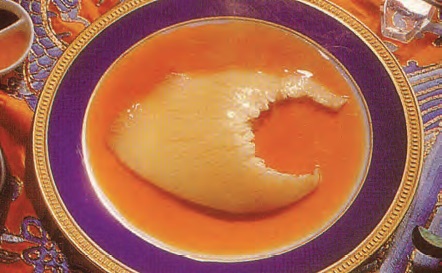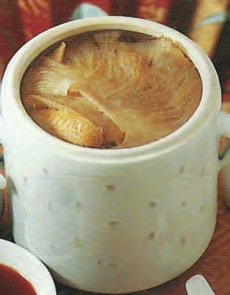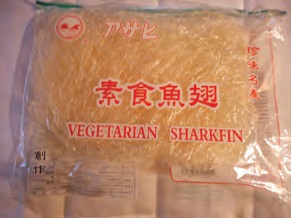
| What is Flavor and Fortune? |
| How do I subscribe? |
| How do I get past issues? |
| How do I advertise? |
| How do I contact the editor? |
Read 12958370 times
Connect me to:
| Home |
| Articles |
| Book reviews |
| Letters to the Editor |
| Newmans News and Notes |
| Recipes |
| Restaurant reviews |
| Article Index (all years, slow) |
| List of Article Years |
| Article Index (2025) |
| Article Index (last 2 years) |
| Things others say |
| Related Links |
| Log In... |
| Authors |
| Categories & Topics |
Sharks and Their Fins
| by Jacqueline M. Newman |
Unusual Ingredients
Spring Volume: 2017 Issue: 24(1) pages: 23 to 27
Nowadays, rich and oily shark meat is popular where once their fins were. The fins are now banned in many places because some say they are becoming endangered. In the past among the Chinese, bowl after bowl of Shark’s Fin Soup was popular before and in the rule of Empress Cixi.
Now, in southern China and Taiwan, a single bowl of this soup at an honorific banquet such as a wedding can cost upwards of five thousand Taiwan dollars or its equivalent in Chinese Yuan, American dollars, or the local currency. Getting real shark’s fin soup is not a reality in many places because serving them is not allowed. At best one can get artificial shark’s fin in soup.
There are more than three hundred different species of sharks worldwide. Even with that number, their soups are no longer allowed in many cities, town, or hotels. Eating this soup is morally unacceptable because sharks are thought to be or becoming endangered species. Their fins when cut off, the rest of the shark returned from whence it came, dies shortly thereafter.

Scientists need an accurate picture of these reducing numbers, distribution, spawning grounds, migration routes, and how many may still be available. Some tell me they do not have that information but do know their availability is rapidly diminishing due to over-fining.
Rich and oily shark meat is becoming popular at Chinese meals while in the past, simply eating their fins was popular at special events. Bowl after bowl of this soup was a required dish at these high-end banquets and important business-deal-meals. The Chinese finalized many a deal with this soup on the table as it impressed all.
Now, thanks to the cooperation of people around the world, the consumption of shark meat may be increasing while the numbers of sharks solely caught for fining has decreased. Is this enough for their numbers to remain the same or better yet increase?
According to one estimate in a New Zealand English language Chinese food magazine, some two hundred million sharks are killed by commercial fishing fleets doing this fining. If lined up head to tail, these mutilated and deceased animals would go around the equator five times.
In ancient records, shark fins became popular and an honorific food long after they were low grade and consumed by common folk. That was during the reign of the Qing Emperor Chien Lung (1736 - 1795). Then, their soup became popular on palace and honorific menus. After that and the death of Empress Cixi, this soup gained greater popularity at high-class banquets.
Today, due to their extensive use in many dishes beside shark fin soup, particularly mako and thresher sharks and many other shark varieties are being fished out of existence. Now, their use and those lesser-valued hammerhead sharks are increasingly sold as shark steaks, stir-fried shark dishes, fish balls made with shark meat and shark fin bisque. Overall, the number of sharks swimming in open waters are decreasing.
At the beginning of the last century, Chinese emigrated and now live on every continent; and they are more affluent than ever before. Therefore, their fins were sought after for many special meals. Most are purchased and shipped to China and Taiwan, sold in large numbers in Singapore, Macao, and other countries with large Chinese populations, as well as in China and Taiwan. Fin consumption has grown steadily at more and more banquets and special events, their soup still a required dish. In Hong Kong, a few years back, more than seven million pounds of shark fins were consumed in one year.
We know of one restaurant in that city, the Sun Tung Luk Shark Fin Restaurant, that closed their doors, but not because of supply issues. They closed them because their customers felt it inappropriate to serve or eat shark fins. They later did reopen, changed them, changed their name, not their ownership, and changed their menu, too. Morality had impacted their bottom line, their customers did demand they stop using sharks fins. They no longer ordered these fins, and many did not eat at their restaurant because they were appalled about fining actually killing sharks.
This attitude grew and impacted Chinese restaurants in many cities and towns, at restaurant chains, and at all places serving shark’s fin soup. People demanded this and municipalities demanded they adhere to it. These places and many people did not want to be responsible for the precipitous decline of and eventual extinction of sharks.
Though this decline came into question, prices of shark fins continued to rise. There was a demand for artificial shark fins, and so fake fin prices rose and are now close to equal, some even higher than real shark fins. People still want to show off and so they order these soups with fake shark fins. They seem to continue to impress, too.

What fascinates is that few seem to mind the term ‘artificial’ on a menu. They still want these soups even if made with fake ones. These soups now cost almost as much as soups with real shark fins, seem to sell well, and their prices are almost as high and some are even higher than those made with the real thing.
People are unaware that sharks are very primitive animals, each having six to eight fins. The marketplace sorts them into three grades according to thickness and location on the shark but does not grade fake fins, to our knowledge.
The best shark’s fins are dried in the sun then softened before use. Dried shark fin is hard and tough needing repeated soaking and simmering. The fins need their scales removed before use.
Their flavor is almost non-existent. Fake or real, they need to be prepared adding the flavor of one or another special food, and they need to be cooked for a long time. A chef in Taiwan told us their meat can be fishy if it has a high concentration of urea. He did ask us if those who read this magazine know that when preparing shark’s fins they need to be cooked with a strong broth and other strong ingredients?
He said that Chinese know that shark’s fins are called sha yu or yu chi, and that chefs need to immediately put the fins on ice. And he went on to say that many chefs, he too,, now use shark meat for other purposes and he thinks this is good. Shark’s fin soup, for the Chinese, may be an honorific dish which he calls ‘an act of generosity’ but now he worries if his livelihood will soon disappear. He hopes not. Have you ever wondered which fin was most prized? He told us that the one on the center back called the ‘dorsal fin’ is the very best. He went on saying side fins were considered second best, tail fins the least valuable. A soup with a whole fin is the very best way to have this soup, and we have written about having this once; we did photograph it and it is shown again on this page from the meal where we had that.
He did tell us that there are hundreds of other ways to serve shark, such as in dumplings, stuffed into chicken wings, or used as a sweet ending a meal. Literature and life tell us that shark’s fins increase the cost of a meal by thousands of dollars depending upon quality and quantity. That means shark fin soup can be from ten dollars for a few strands of a fin to a few thousand dollars for one bowl with a whole shark fin in it.
In Canada’s Ontario Province years ago, we did visit a place called ‘Shark Fin City.’ They gave us a brochure that we share on this page, their Shark Fin Soup shown in a white crock. They did not serve us or anyone a taste.
In Taiwan, we did eat with the owner of the previously mentioned shark fin restaurant before it morphed into something else. He told us he was feeling the economic pinch, said many of his frequent customers did not even want to be seen in his place. At that time, he was ready to change the name of his restaurant and its menu; and later did.
Some hotels no longer serve shark’s fins in their restaurants, though a few still do. More often than not they serve artificial shark’s fin in dishes or just a few real fin pieces with crab meat or with abalone. Their managers tell us they only use imitation fins.
TCM practitioners tell us that real fins can cure diabetes, reduce indigestion, and benefit Qi in men and women, and decrease cancerous tumors, reduce pain from arthritis, and heal serious wounds faster than anything else they know of.
To those who ask: are there different kinds of shark fins, the answer is yes. Look in your local library for the book titled: Musings of a Chinese Gourmet by F. T. Chang. It has many pages of enthusiastic guidance for handling the fins of real sharks, how to cook them on a bamboo mat, serve them at extravagant banquets, prepare them properly, etc. It advises not to deal with shark meat, just enjoy those cartilaginous needles from the fins. When cooking shark’s fins, we read that they should be soft and chewy after simmering for two hours or more. That author suggests rinsing them many times, cutting them into small squares, freezing them for later use, etc. He says that when unavailable, to substitute slivered sturgeon skin in their place.
While most TCM practitioners we spoke to say the needles from shark fins cure many things, not every one of them believes there is enough reliable information to substantiate that. A few blatantly said they are ineffective while some theorize that they may inhibit angiogenesis and prevent blood vessel growth. Not all are in agreement.
There are folks with seafood allergies who do not eat any fins. Some say they do get a bad taste in their mouth, others complain of dizziness, constipation, low grade fever, yellowing of the eyes, etc. while others only complain of their cost.
Many who want to serve shark purchase a small shark so they get very small fins. One gal said she serves these small items with crab meat and eggs, and did so celebrating the birth of her first grandson. Another told us she served them at her husband’s sixtieth birthday party. One fellow said he heard they were served at a New Year’s Eve party his friend called ‘Around the Stove Feast.’ His wife did not attend. Another chap said shark fins are a wish for ‘surplus’ meaning ‘money’ in the days ahead; and he is for that but has yet to have any.
Here are a few classic shark recipes, and all can be made with artificial shark fins. There is also a shark lip recipe. Enjoy them all!
| Shark's Fin Thick Soup |
|---|
5 ounces shark’s fins
1. Boil shark’s fins for half an hour, then soak them
overnight, rinse them, and discard any hard parts.
|
| Vegetarian Sharks Fin Soup |
|---|
4 ounces fresh coriander
1. Knot half the soaked day lily pieces.
|
| Imitation Shark Fin Soup |
|---|
1 sea cucumber, soaked overnight until very soft, remove
1. Prepare sea cucumber, mushrooms, chicken, and
shrimp, toss them together, microwave them for four
minutes, then set them aside after mixing with wine
and cooled.
|
| Imitation or Real Shark Fin Dumplings |
|---|
20 dumpling wrappers
1. Mix minced pork, mushrooms, gizzards, shrimp, and
artificial shark fin pieces with the egg white.
|
| Shark Fins, Meat, and Seafood Soup |
|---|
1/4 cup fish paste
1. Mix fish paste, minced soaked dried shrimp, shark’s
fins, chicken fat, scallions, minced carrots and
mushrooms, egg white, salt, sesame oil, and rice wine
and roll into balls and roll them into the cornstarch.
|
| Shark Fin Lips and Abalone |
|---|
1 cup shark fin lips, soaked until soft
1. Bring six cups of water to the boil, add the lips,
abalone, and the pork simmer for one hour. Then add
the zucchini and simmer an additional half an hour.
|
| Imitation or Real Shark Fins and Wings |
|---|
½ cup fresh real or prepared imitation shark fins
1. Simmer shark fin in boiling water with ginger and
sugar, then drain, and put them on a heat-proof plate.
|
| Imitation Shark Fin, Corn, and Egg Whites |
|---|
1 cup imitation instant shark fins
1. Mix shark fin pieces with the crab meat and white of
the scallion, bean sprouts, and the wine and set aside.
|
| Imitation Shark Fin In Gourd |
|---|
2 large Chinese black mushrooms, soaked for an hour,
1. Mix minced mushrooms, ground bonito, and the
minced belly pork.
|

Copyright © 1994-2025 by ISACC, all rights reserved
Address
3 Jefferson Ferry Drive
S. Setauket NY 11720
